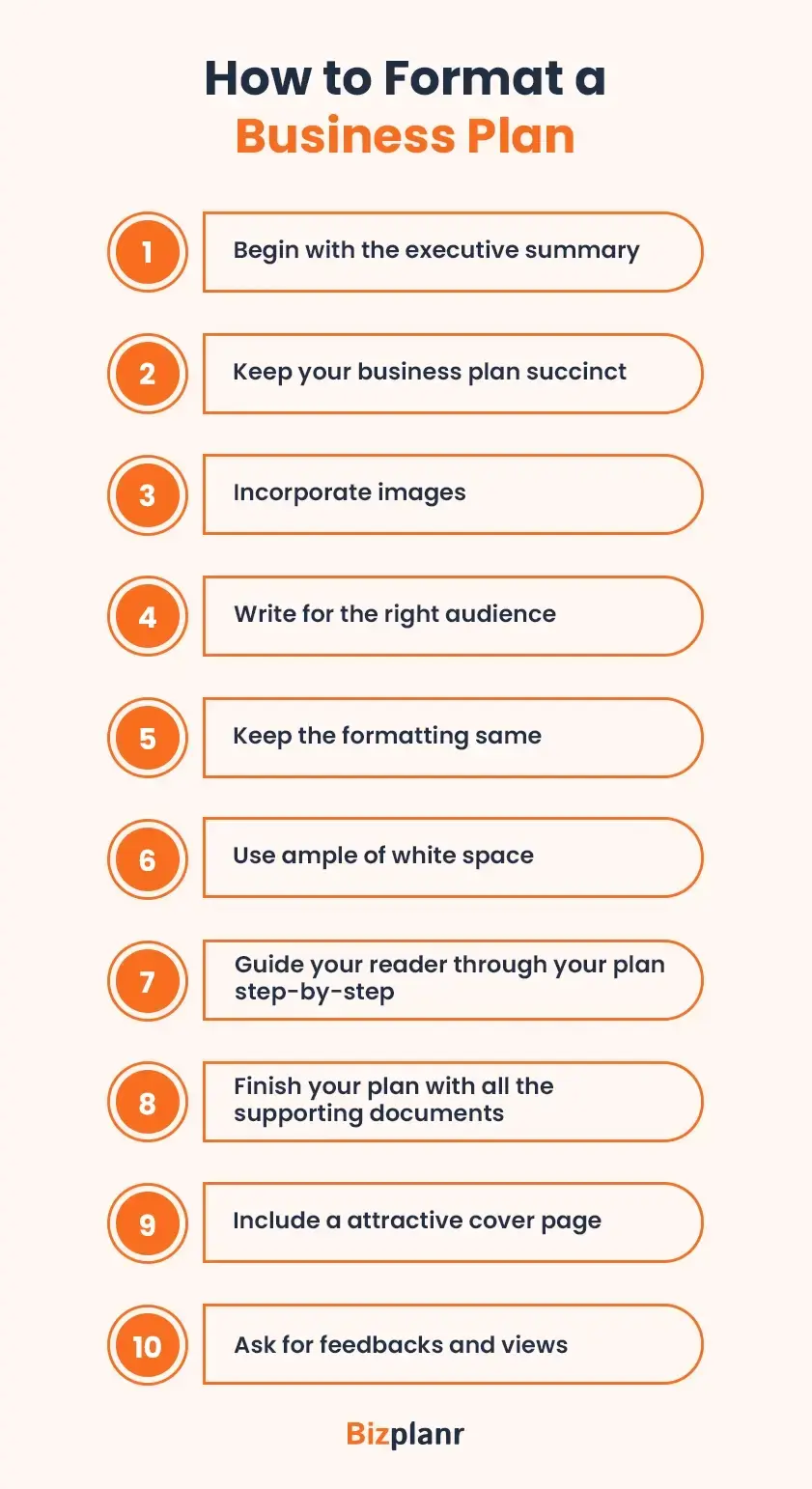Your business plan is a multi-purpose tool. You need it to secure funding, give your team direction, and map out how you'll grow.
That’s why knowing how to format a business plan is necessary to ensure your business plan is best designed to meet these goals.
Now, there's no single "right" way to organize it, but you must keep a few things in mind to ensure your business plan looks professional and covers all the information.
Moreover, if you're trying to get investors on board, your plan must knock their socks off (and include some specific financial details). Even if your plan is primarily for internal use, proper formatting is still important for clarity and proper communication.
So, here are our 10 tips that can help you achieve the right format.
1) Begin with the executive summary
The executive summary is the starting pitch of your business plan. It’s where you’ll set the tempo for the coming sections of your plan.
Keep it short and easy to understand, ideally just one or two pages. It’s because you only have a few initial moments to grab your investors' attention. (They go through a lot of business plans, and probably won't have time to read through a whole plan)
But what must your executive summary focus on? Your company description and the products or services you offer.
For the company description, think of it as your company's highlight reel. What's your mission? What are your goals? Give a quick rundown of your history, your leadership team, and your biggest wins.
Basically, let potential investors know who you are, why they should care, and how you're making a difference.
Next, you should talk about your products and services. No need to be extremely detailed here, just give them a taste of what you offer and what sets you apart. Throw in some bits about your financial projections, and your edge over the competition.
2) Keep your business plan succinct
Although there’s no predefined length of a business plan if your executive summary hooks readers, aim for 12 to 15 more pages—max.
This is because people are busy. They might skim through your plan while on a call or checking emails. If your business plan is too long that means you’ve not summarized it very well.
So, avoid repeating yourself, cut unnecessary words, and use short paragraphs and bullet points. Plus, don't try to fit everything in with tiny fonts and margins. Remember, this is about communicating your ideas, not writing a bestseller.
3) Incorporate images
Images are a great way to connect with investors on a gut level. Why?
It's simple: we're visual creatures. In fact, 90% of the info our brains process is visual. We connect with images more deeply than words alone.
Images can also convey complex ideas and emotions that words can't always capture in isolation. For instance, if your company uses advanced tech, a visual can give investors a better idea of it than a paragraph full of jargon.
This is especially true for data. A well-designed graph can more impactfully tell a story that would take a lot of boring text to explain.
But, don't go overboard.
You still need to keep your plan concise, and images take up space. Use them strategically so they provide investors with a powerful snapshot of your business and growth potential.
4) Write for the right audience
One of the most important things when writing a business plan is to understand who you're writing for. Only then can you speak their language and highlight the information most relevant to your reader’s interests.
For example, let's say your business plan is for a new battery technology. Investors from the same background would be interested in knowing the chemical composition and charging cycles of the battery.
On the other hand, a non-technical audience would be more interested in the market potential and financial projections of the venture instead of the technical part.
So you need to consider a modular approach over here. Write a core business plan that focuses on the big picture using clear, concise language.
This core plan would cover essential elements like the company overview, value proposition, and financial projections in a way that's easily digestible for everyone. Then, create separate documents or appendices for the technical stuff. This way, everyone gets the information they need without feeling confused.
5) Include an attractive cover page
The cover page is your business plan's first impression, so keep it simple and elegant. It sets the tone for everything that follows.
Your company name should be the star of the show, in a big, bold font. Add your tagline, logo, date, and contact information.
Keep the design neat and consistent to look professional and organized. Try:
- Equal character and line spacing.
- Similar or identical fonts throughout.
- Centering each line for a clean look.
Before finalizing it, proofread it multiple times and ask others to review it too.
6) Optimize your business plan's presentation
For the overall look of your plan, use single spacing with some extra space between each paragraph. If you're printing it out, a classic serif font like Garamond or Baskerville looks professional. But, if most people will be viewing it on a screen, choose a clean sans-serif font like Verdana or Arial.
Why different fonts?
Research shows serif fonts are easier to read on paper, while sans serif works better on screens.
But mind you: Don't overthink the font choice. Just pick one of the four options mentioned above and move on.
Keep the font size between 10 and 12 points for easy reading. If your plan is too long, trim some content instead of shrinking the font. The same principle applies to margins: stick to the standard one-inch margins for readability.
7) Use ample white space
Give your reader's eyes a break with plenty of white space around the text. Make sure you have generous margins on all sides, especially on the left. Also don't forget the right margin—it's handy for notes.
Don't double-space lines or put two spaces after punctuation marks. Your computer's got that covered.
Next, avoid the two formatting faux pas: "widows" or "orphans".
What are they?
Imagine you're reading a document, and suddenly, there's a sentence all alone at the top of a new page. Or even worse, just one word hanging awkwardly at the bottom. These formatting mistakes are called "widows" and "orphans" and can mess up the flow of your business plan—making it look sloppy.
To fix it, rewrite a sentence or adjust your word processing settings to get rid of them.
Lastly, go easy on the colors, especially if you intend to make copies. Not all colors show up well in black and white, so test it out before finalizing your plan.
8) Guide your reader through your plan
A well-organized business plan flow should be logical and give information about your business step-by-step.
Start by providing an index or table of contents at the beginning, giving a quick overview of each section. This allows your readers to easily find the information they need.
Then proceed with the executive summary, your attention-grabbing introduction. After that, move on to a detailed company description. This includes your mission, vision, history, and business structure, giving a clear picture of your company.
Next up: market analysis, marketing and sales strategies, and your operational plan. This is where you'll introduce your target market, revenue projections, cash flow, and funding needs.
Finally, wrap it up with your financial plan. This is where you'll show the numbers that back up your business idea.
9) Finish your plan with all the supporting documents
Most people don't pay much attention to the appendices section of a business plan. But guess what? It's super important. It is a backup band for your main act—providing the supporting evidence and details that back up your claims.
Some common supporting documents you can add in the appendices are:
- CVs of your management team
- Credit histories
- Licenses
- Patents
- Legal documents
- Detailed monthly financial data
- Any external data you've used or referenced
Once you know what you want to include, make sure it’s organized. Here's how to ensure your appendices are easy to understand and add value to the plan:
- Each document needs a clear title and a brief description explaining why it's important and what it shows.
- Number each document for easy reference.
- Refer to the relevant document in the main body of your plan (e.g., "For more details, see Appendix 4.6").
10) Ask for feedback and reviews
The last tip for formatting your business plan? Get a second opinion.
When you've been working on something for a while, it's very human to make little mistakes. So, to avoid that, ask a friend or hire a professional to read your plan and give it a final edit.
Typos and grammatical errors can make a bad impression. A fresh pair of eyes can catch those issues before anyone else does.
Summing it up
You might have the next big idea, but the way your business plan looks and reads is what gets you past the first round. Not sure if yours is up to par?
No worries, you can always rely on a Free AI business plan creator like Bizplanr. It can take your brilliant business idea and turn it into a plan that grabs attention. All you have to do is answer a few questions regarding your business and let the AI do its magic.
Say goodbye to formatting headaches and test Bizplanr AI business plan generator for free today!
Get Your Business Plan Ready In Minutes
Answer a few questions, and AI will generate a detailed business plan.
Frequently Asked Questions
How long can my business plan be?
Business plans vary in length. Some are short and sweet, coming in at 2-20 pages. Others are much more detailed, sometimes stretching to 50 pages or more.
But the length debate is subjective. It will depend on a few things like how complex your business model is, what stage your business is in, and who will be reading your plan.
Should I use white space in my business plan?
Yes, because it gives your reader's eyes a rest. Ample margins–top, bottom, left, and right – give the reader space to breathe and time to think. Pay special attention to the left margin if you plan to bind your business plan. Plus, a generous right margin also helps as it leaves room for notes and comments during revisions.
Is a table of contents necessary?
A table of contents guides the reader through the different sections. And makes it easy for them to jump to the parts they're most interested in. It normally sits at the beginning, giving them a quick overview of what's to come.






